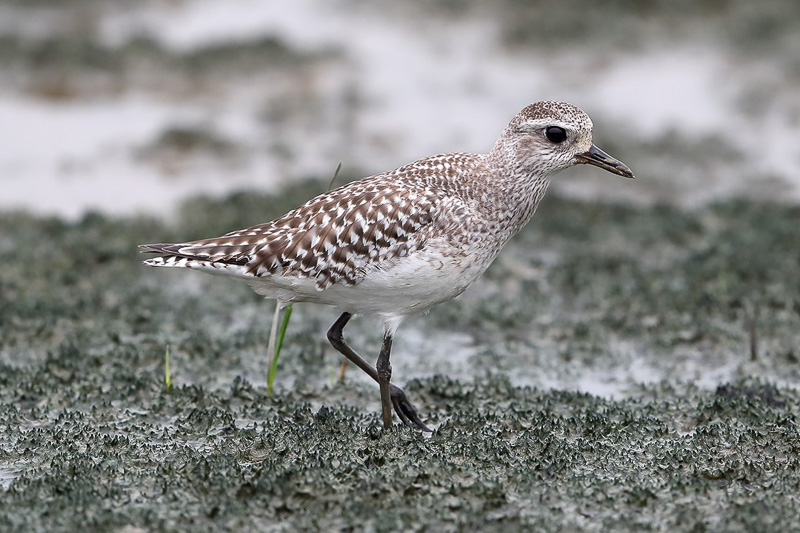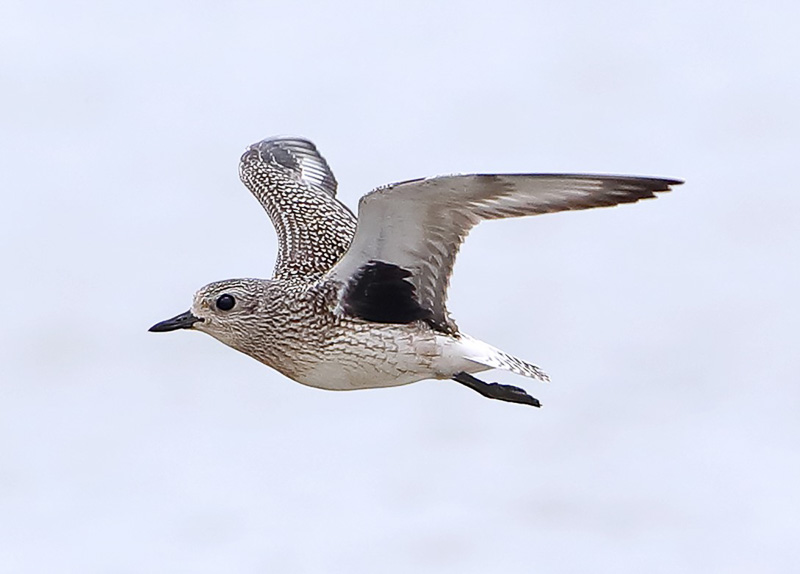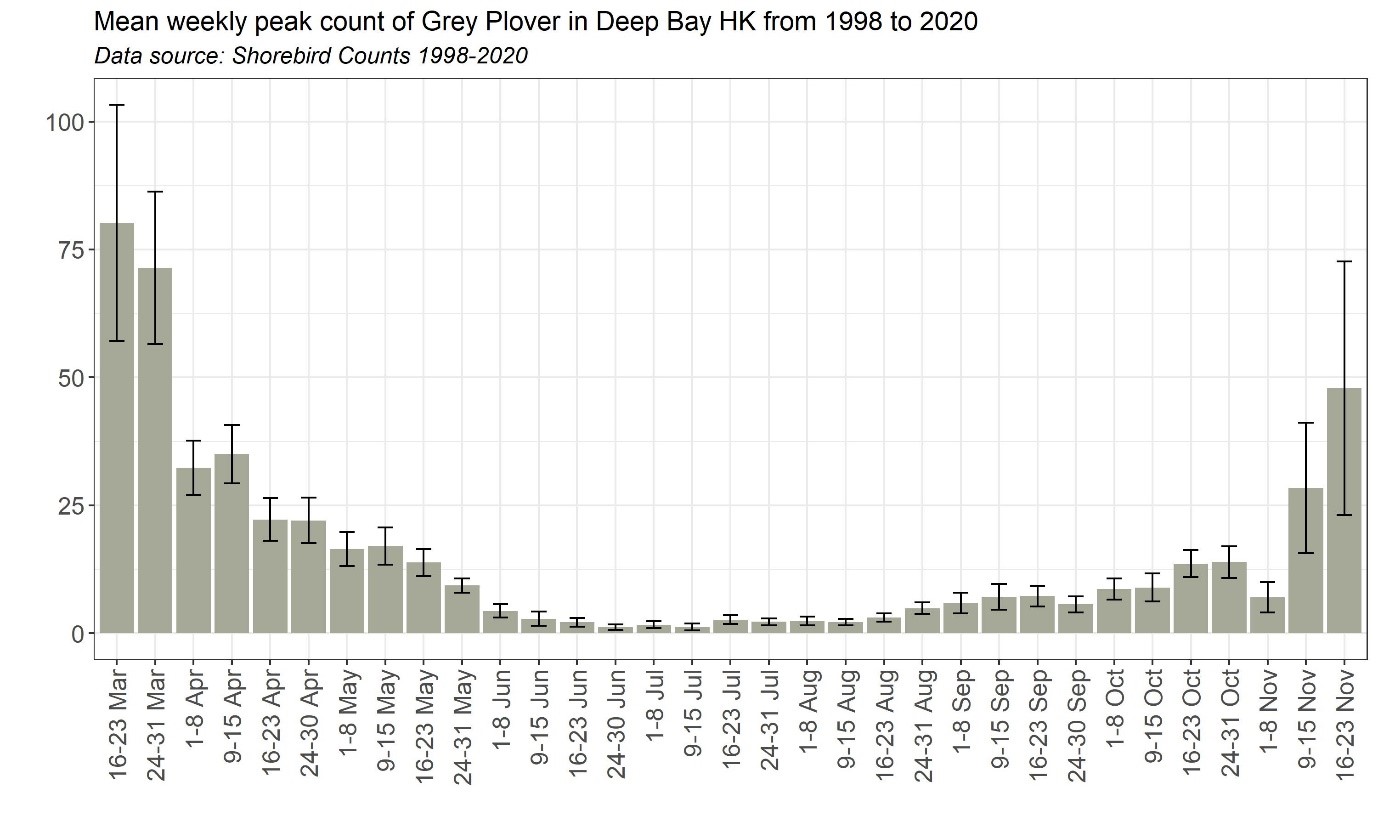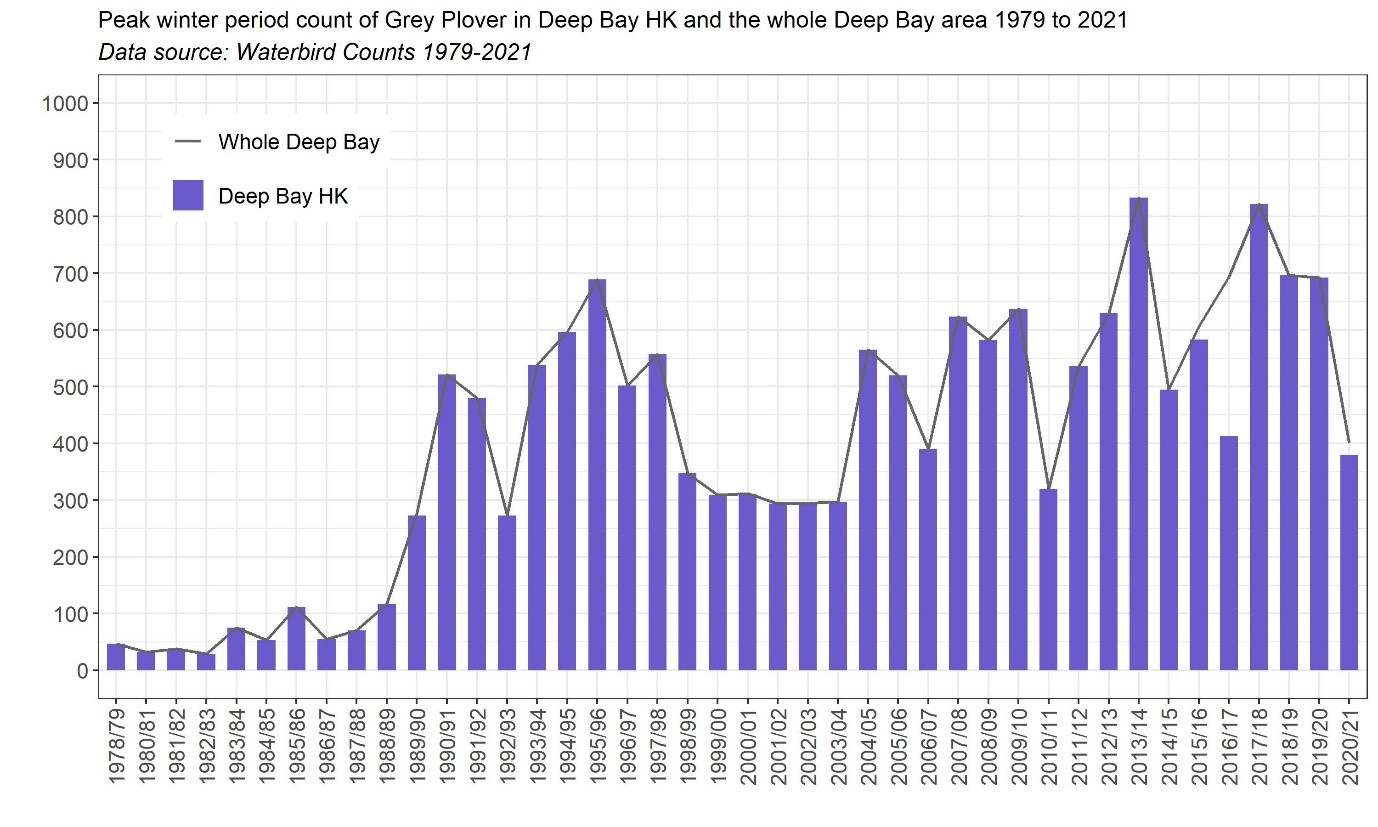Grey Plover Pluvialis squatarola 灰斑鴴
Category I. Abundant winter visitor, scarce passage migrant and summer visitor.
IDENTIFICATION

Apr. 2017, Michelle and Peter Wong.
26-29 cm. The largest plover in HK, with relatively large head and bill. Distinctively grey in most plumages. Most birds in HK are in non-breeding plumage, in which the greyish upperpart feathers have diffuse pale fringes or bars, the chest is greyish and the rest of the underparts whitish. Juveniles in autumn have buff tones to the upperparts, though such birds appear to be rare here.

Oct. 2018, Michelle and Peter Wong.
In flight shows distinctive black axillaries and obvious white wing bar.
In breeding plumage, the face and underparts are black as far as the vent (not solidly so in females); white extends from forehead over eye, behind face to chest sides and upper flanks. Birds in fresh breeding plumage are rarely seen in HK, but worn and faded breeding plumage can be seen in moulting adults in autumn.
VOCALISATIONS
The typical call heard is a somewhat mournful whistle that has a lower-pitched central portion that may or may not be stressed.
DISTRIBUTION & HABITAT PREFERENCE
The great majority of records are from the intertidal mudflats of Deep Bay (as far as Pak Nai) and adjacent roosting areas of Mai Po NR. Has also been recorded on intertidal mudflats at Starling Inlet, though the highest there is only eight. It is very rarely recorded on fish ponds, with fewer than ten records in that habitat this century.
There are few records away from areas of intertidal mudflat, with generally no more than three birds noted at the following localities: Tung Ping Chau, the former airport at Kai Tak, Sai Kung, Tai Long Wan, Pui O, Shui Hau, Tai Po and Shuen Wan/Ting Kok, where the highest count was 18 on 2 December 2016. At Kai Tak Grey Plover was recorded both on passage and in winter as part of regular observations during 1974-79, in contrast to the Chek Lap Kok airport site at which it has not been recorded. Small numbers have also been noted on migration over the sea to the south of HK.
OCCURRENCE
Grey Plover is primarily a winter visitor, with small numbers occurring on passage and during the summer.
Autumn passage appears to occur from at least the last week of August and possibly as early as the third week of July (Figure 1), with adults or first-summer birds predominating in early autumn. Passage at this time is generally rather weak, usually with no more than 25 birds recorded, and the earliest three-figure count has occurred on 11 November. The bulk of the wintering flock appears to arrive in the last half of November and first half of December.
As can be seen from Figure 2 peak winter counts during from 1990/91 to 2003/04 were generally 300 or more, the highest being 751 on 28 January 1994 and 689 on 13 January 1996. An increase began in winter 2004/05 when it was over 550; since then, numbers recorded wintering have generally been over 500, with the peak counts being 833 on 19 January 2014 and 822 on 18 February 2018. In addition, there have been two higher counts, both in March: 881 on 13 March 2016 and 840 on 17 March 2014. It is possible that these counts included migrants, though the wintering flock appears in some years to remain largely intact to the first or second week of March. Numbers in midsummer are low, with the highest count in July and the first half of August being 18.
Although noted by Swinhoe (1861) in February, the next Hong Kong record was that of Herklots (1953) who recorded one in April 1941. HKBWS records provide peak winter counts of 30 or fewer until 1975-76, while from 1976-77 to 1988-89 the highest winter count was 119; however, these low counts are likely due to limited access to intertidal areas.
BEHAVIOUR, FORAGING & DIET
Uses a slow ‘stop-run-peck’ foraging action to capture polychaetes and small bivalves in intertidal areas. Moves more slowly than its congeners during foraging and is often some distance from the main mixed-species flocks of shorebirds suggesting that it prefers areas in which its prey is less disturbed or drier parts of the mudflat.
The wintering flock does not roost on Mai Po NR at high tide, and its location at this time is unknown. Birds present in spring, summer and early autumn, however, are seen with other shorebirds on the Reserve at high tide. Less gregarious than other plovers, birds are often spread out across the mudflat making them difficult to count accurately at lower tide levels.
RANGE & SYSTEMATICS
Holarctic breeding species from northern Russia east to Canada, Grey Plover winters worldwide in tropical and mild temperate coastal areas (Poole et al. 2020). In China a widespread migrant wintering in coastal areas of the south and southeast, including Hainan and Taiwan, and the lower reaches of the Yangtze; over-summering birds occur on the east coast (Liu and Chen 2020).
Three subspecies are recognised, two of which are more likely to occur in Hong Kong. The nominate breeds across north Eurasia and Alaska, while P. s. tomkovichi breeds on Wrangel Island, northeast Siberia. The third subspecies, P. s. cynosurae breeds in Canada.
CONSERVATION STATUS
IUCN: VULNERABLE. Population trend decreasing, with increasing evidence of rapid population declines over the past three generations (23 years), estimated to be more than 30%.
Figure 1.

Figure 2.

Poole, A. F., P. Pyle, M. A. Patten, and D. R. Paulson (2020). Black-bellied Plover (Pluvialis squatarola), version 1.0. In Birds of the World (S. M. Billerman, Editor). Cornell Lab of Ornithology, Ithaca, NY, USA. https://doi.org/10.2173/bow.bkbplo.01
Swinhoe, R. (1861). Notes on the ornithology of Hong Kong, Macao and Canton, made during the latter end of February, March, April and the beginning of May 1860. Ibis 1861: 23-57.

